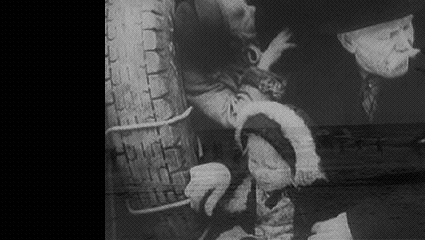
Link shall be added later
Technical Details
Duration: 6 minutes, 8 seconds
-{{{child}}}-
>>>NEEDS EDITING<<<
{{{child}}} is a collage/montage made entirely out of free-domain, archival footage. The vast majority of the material originated from newsreels and propaganda films. To the best of my knowledge, all of the scenes of combat and carnage are genuine.
In this narrative, an average young American boy, mesmerized by the technology of war, envisions the supposed glory or joy of firing the most terrifying weapons ever created. He knows not where, he does not care. The boy, surrounded by beliefs in the righteousness of one nation over another and the supposed glories of warfare, fires his rocket. The narrative that follows depicts the armed forces of the world moving to engage one another. The chaotic conflict is unleashed and quickly leads to the obliteration of small towns and cities. As the malevolent machine of destruction marches onward, the civilian populations flee their homelands. Then, the large cities and capitals are bombed, leaving the refugees nowhere to flee. The soldiers themselves march to their own doom, with no one left to trumpet the empty glories of their mindless struggle, and no way to escape the tragedy. These, however, are the struggles of the past and the child has no way to comprehend the significance of these events. So, he continues to dream of the future, in which he to can participate in the continued bloodshed as though it where a game.
My goal for {{{child}}} is to challenge the manner in which war is frequently depicted, particularly to the very young. It is not really possible for children to comprehend the sorrow and horror of the past and we shouldn’t expect them to. Yet, it is an exploitation of their innocence to portray those tragedies as glorious deeds, worth emulation. This is exactly the sort of paradigm that led to the first and second world wars, which make them exceptionally appropriate to reference using the actual filmed record of those events. Like countless nations before it, militarism and nationalism led Japan down a path that led to utter devastation, millions of lives lost and decades of struggling to reclaim its great potential as a world leader. These days there is valid concern that the United States may be heading along a similar path. The U.S. was the only major power in both of the world wars to not suffer massive devastation within its traditional borders and it prospered into the ensuing decades. As such, the American populace never absorbed the full sorrow of those conflicts and remains vulnerable to nationalist movements, as the aftermath of the terrorist attacks on the U.S. in 2001 CE made clear. After the attacks, most of the public was swept up in the passions and rhetoric of the moment and tolerated the imposition of limitations on previous freedoms in the name of security, and enthusiastically supported the invasion of two sovereign nations. The point of this piece, however, is not to question the legitimacy of those events, but to call to attention this vulnerability to manipulation. Another example of this glorification of military prowess without comprehension of the human and environmental consequences, is the widespread belief in the U.S., that the use of nuclear weapons on Japan was justified, even righteous. There is a great contrast between how war is portrayed between the education systems and media of Japan and much of Europe verses the United States in general. In schools of these nations, children are given a more balanced explanation of each side in these conflicts and The horror of it all is given great attention. This is often not the case in the US and is even more evident in how the events are typically portrayed in U.S. popular media.
While each of these particular issues is worthy of much attention, the essential purpose of the piece is not to question current events and it is not an indictment of children being exposed to violent media. It is a challenge to how war is so oft portrayed. The essential hope of this film is to preserve the communal memory of the tragic cycle of warfare in the first half of the last century as a lesson that the children of today may take to heart, without having to experience similar horrors.
Music by Boris & sunn O)))
H21
2009 CE copyright